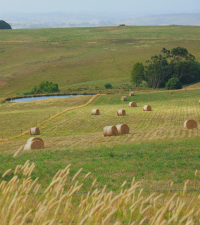
Sustainability software provides the most efficient, flexible and cost-effective way to measure, track, model, reduce and report on ESG metrics.
Effective software streamlines the entire carbon emissions measurement, management and reporting process for food companies. The best solutions also go beyond carbon data by assessing impact across additional ESG metrics and providing support for environmental marketing claims and regulatory compliance.
With the right software, you can automate carbon footprinting to support internal requirements and external regulatory timelines, including:
- Carbon reporting for SBTi FLAG and GHG Scopes 1, 2 and 3
- Product carbon footprinting across your full portfolio of products and ingredients
- Forecasting reduction scenarios and modeling abatement strategies
- Facilitating supplier engagement
- Automatically incorporating primary data
- Validating external-facing climate and sustainability claims
Food companies can accelerate footprint reduction and confidently be compliance-ready by using these tools to consolidate carbon data onto a unified platform, more accurately measure product carbon footprints and plan impactful emission reduction strategies.
Holistic sustainability software also facilitates engagement with internal and external stakeholders, providing transparent emissions reporting and data-backed communications on climate claims.
Companies who adopt audit-ready carbon accounting solutions gain a significant advantage over those using older traditional methodologies. Previous solutions rely too heavily on either collecting primary supplier data or using overly-generalized emissions databases and spend-based accounting methods.

The ideal platform automates and simplifies the process for food companies to set highly-accurate emissions baselines, develop analytics-driven decarbonization strategies, and comply with evolving regulations and supply chain demands.
Sustainability Software: What to look for
Make your vetting process more efficient by knowing what features, methodologies and tools to look for in a platform.
All-in-one sustainability solutions designed for food companies should meet the following minimum requirements:
Product Carbon Footprinting
Comprehensive Product Carbon Footprints (PCF) provide the cradle-to-grave carbon lifecycle at the ingredient, product, and brand-level. Accurate PCFs are not only necessary for reporting, but also essential for driving impact reduction.
Look for platforms that draw from databases with granular, crop- and location-based emissions factors across a broad ingredient database. This level of granularity enables real-time insights into your footprint and can inform upstream activities in your R&D and Procurement functions.
Carbon Accounting for Scope 1, 2, and 3
Look for comprehensive carbon accounting across Scopes 1, 2, and 3 in accordance with the GHG Protocol framework, along with the land use metrics necessary for SBTi FLAG targets. Reports should be easily-exportable for ESG reporting.
For food companies, an average 87% of emissions are within their Scope 3 inventory, so utilizing a platform that specializes in agricultural emissions data will provide more accurate baselines for the most carbon-intensive areas of your supply chain.
Carbon Reduction and Abatement Strategies
For companies looking to not only measure impact, but identify the most efficient ways to reduce their footprint, platforms that help you identify your highest-emitting ingredients, products, and suppliers are essential. Look for those that allow shared access across Sustainability, R&D, and Procurement teams for more efficient decision-making across possible interventions.
Scenario Planning
Effective scenario planning tools provide advanced modeling and forecasting to enable robust abatement and carbon reduction strategies. Look for features that model the reduction potential of ingredient swaps, changes to agricultural practices or sourcing locations, and offer integrated supplier engagement paths.
Supplier Engagement
A dedicated Supplier Portal fosters active engagement with suppliers, a key component in achieving comprehensive carbon reduction across the supply chain. While some platforms rely on primary supplier data from the start to provide accurate baselines, others will offer granular data out-of-the-box, and provide methods for focusing on your key, highest-emitting suppliers over time to gradually increase the accuracy of your footprinting.
Auditability
Scalable solutions offer a strong emphasis on auditability, aligning with global reporting and data security standards like CDP, GRI, CSRD, and ISO, while ensuring transparency in data sources. Be sure to check that any provider’s carbon footprinting methodology is aligned with GHG Protocol in order to future-proof your climate disclosure and ESG reporting.
Automation
Look for tools that enable streamlined uploads where you want to use primary data; or direct access to crop- and location-based emission factors for higher accuracy than global averages. For enterprise food companies, explore platforms that offer an API for a more scalable and streamlined option.
Sustainability Claims
If you plan to communicate publicly about your impact or leverage your footprinting in marketing or sales campaigns, opt for a platform that supports the validation of sustainability claims with data-backed evidence. In an environment of increased skepticism and greenwashing, engaging a trusted 3rd party data partner will help you authentically communicate your commitment to sustainability without exposing you to risk.
Certifications and Carbon Accounting Frameworks to look for in a sustainability platform
Certifications represent a company’s commitment to adhering to recognized global standards for reporting and data integrity. Here’s what to check for:
Has the solution been certified and audited for AICPA SOC 2 Type II compliance? A SOC 2 Type 2 Report is a Service Organization Control (SOC) audit on how a cloud-based service provider handles information security. It covers both the suitability of a company’s controls and its operating effectiveness.
Does the solution calculate product carbon footprints based on the GHG Protocol – Product Lifecycle Accounting and Reporting Standard?
Does the solution calculate product carbon footprints based on the ISO 14067:2018 Greenhouse Gases — Carbon footprint of products?
Does the solution calculate product carbon footprints based on Carbon Trust’s Product Carbon Footprint – Requirements for Certification V2.0?
Bridging the gap between carbon accounting software and actionable strategy
Carbon accounting and ESG reporting—historically complex and time-consuming—has become even more intensive for the food industry.
Requirements for detailed Scope 3 emissions calculations, along with pressure from consumers and investors, has set new standards in carbon reporting, going beyond the basic reporting of Scope 1 and 2 emissions. To meet these requirements without overextending resources, food companies are turning to carbon accounting software capable of automating data collection, analysis, and reporting.
HowGood’s carbon accounting solution is fundamentally designed to make reduction strategic and actionable. Companies can quickly identify and prioritize reduction opportunities by discovering how individual materials, products, suppliers, or portfolios contribute to their total carbon footprint. In addition, the ability to model the impact of changes to product formulas, sourcing, and purchasing volumes facilitates decision-making across the organization and helps reimagine viable options.
Gaining access to product carbon footprinting at scale means that food companies achieve a more accurate reflection of their corporate footprint. This provides expanded capacity to effectively forecast and strategize toward reduction.
Which sustainability software solution is best for your company? The answer lies in identifying a solution that not only meets the current standards but is also equipped to adapt to the dynamic landscape of carbon management and reporting.
Download the Buyer's Guide
Understanding the key features and assets to look for is critical in accurately vetting carbon accounting software. Download our full Buyers’ Guide for Sustainability Software, including a comprehensive checklist of questions to ask when searching for and comparing solutions.



.png)
